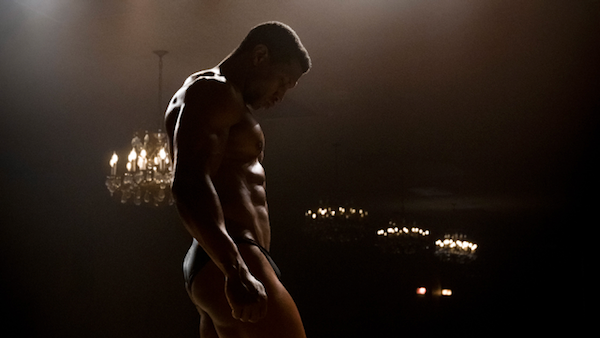Movie review by Greg Carlson
One of the most buzzed-about movies at the 2023 Sundance Film Festival was “Magazine Dreams,” the sophomore feature from writer-director Elijah Bynum. The film, starring Jonathan Majors as a rage-prone bodybuilder, is not a home run, but it is a significant improvement over the filmmaker’s 2017 debut “Hot Summer Nights,” a disappointing neo-noir thriller. “Magazine Dreams” owes a heavy debt to “Taxi Driver,” but Bynum flips the paranoia and racism of the white Travis Bickle to ponder the experiences of Black Americans under threat for merely existing. Too grim to signal the likelihood of mainstream box office success, “Magazine Dreams” will draw attention for the muscular (in all senses of the word) performance of the increasingly vital Majors.
Not unlike some of the remarkable physical transformations made by Robert De Niro in the pursuit of total character immersion, Jonathan Majors spent hours following a brutal training regimen to add a key credit to his already impressive filmography. The ominously-named Killian Maddox certainly seems like a “mad killer,” despite caring for his aging grandfather William (Harrison Page) and seeing a counselor (Harriet Sansom Harris). Bynum foreshadows tragedy, laying out clues like a breadcrumb trail, but it is Majors who molds Maddox into a formidable monster, alternating between pathetic vulnerability and terrifying violence.
Whether consciously or not (and it is difficult to imagine not), Bynum borrows liberally from Paul Schrader’s legendary “Taxi Driver” screenplay, and a number of scenes in “Magazine Dreams” mirror Bickle’s grim descent toward homicidal action. In one, Killian finds the courage to ask grocery store coworker Jessie (Haley Bennett) out for dinner. He may not order black coffee and apple pie with a slice of melted yellow cheese, but Jessie’s realization that her date is not entirely safe comes just as quickly as Betsy’s cut-off of Travis. Taylour Paige, as a sex worker identified in the credits as Pink Coat, doesn’t completely align with Jodie Foster’s Iris, but her big scene is one of the film’s most memorable.
Bynum also doesn’t go so far to include a smooth-talking Easy Andy, but “Magazine Dreams” is no less unsettling when Maddox puts together a small arsenal that includes the all-too-familiar type of assault-style rifle used in so many horrific mass shootings. Instead of Bickle-style diary voiceovers, the filmmaker substitutes Killian’s Google searches – which pose queries like how to be remembered and how to get people to like you. The results in both movies are similar. The deeper we follow the protagonist’s downward spiral, the more we dread the inevitable.
“Magazine Dreams” succumbs to some repetitiveness, but I sincerely appreciated Bynum’s final-act choices, which keep viewers on high alert with more than one welcome surprise. What transpires before the tense climax poses more questions than answers, and not all of the director’s intentions are clear. I’m still not sure what to make of the resolution to the subplot tracing Killian’s hero-worship of bodybuilding idol Brad Vanderhorn (Mike O’Hearn), which teeters on a wobbly tightrope between homoeroticism and homophobia. Other scenes, like the one in which Killian has an ugly altercation with a past tormentor at a diner, strike with the brilliance of lightning.
